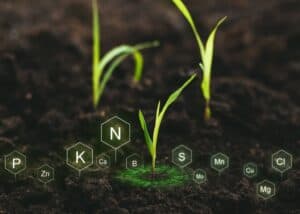In order to raise or maintain plant growth on a particular plot of agricultural land, nutrient management plans are crucial. Consistently high soil fertility is required to meet crop needs throughout the growing season to maximize the expected yield.
Fourteen nutrients are provided to crops by soil and fertilizer. Six are considered macro nutrients, while the remainders are secondary nutrients or micro nutrients. However, a deficiency in micronutrients can be just as detrimental to yield and profitability as a deficiency in macronutrients.
Determining Essential Nutrients Needed
Soil tests are essential for understanding which nutrients are presently available and which nutrients may be in short supply. Deficiencies will have an effect on crop quality or output, and understanding them can help determine the quantity and type of fertilizer or animal manure necessary and the crop nutrient requirements. However, soil testing is extremely dependent on field-specific soil sample procedures. Guidelines for soil sampling where you will get soil particles can be found online and through extension services.
Analysis of plant tissue can also be used to determine the available nutrient levels of a plant during its growth. This analysis is a beneficial tool for cultivators seeking to comprehend the efficacy of their fertilization methods. Tissue analysis may also be useful for diagnosing certain production issues. Similar to effective soil solution, plant tissue analysis is only as accurate as the submitted soil type samples. Guidelines for proper tissue sampling are available online or via local extension agents.
More Nutrients For Improved Plant Health
There are two categories of essential nutrients: macronutrients and micronutrients. Nitrogen (N), phosphorus (P), potassium (K), sulfur (S), calcium (Ca), and magnesium are the six elements typically categorized as macronutrients (Mg). Plant roots absorb these nutrients primarily in ionic form.
Nitrogen (N) is one of the essential plant nutrients to grow in the greatest quantities and is typically the limiting nutrient for plant growth the most. The utilization of N is usually higher than that of all other macronutrients and micronutrients combined. Nitrogen deficiency is something to look into because N is important for photosynthesis, healthy cell growth, and reproduction. It is essential for the production of chlorophyll (which gives leaves their green hue). It also supports stem and leaf development. N is absorbed in the form of nitrate (NO3-) and ammonium (NH4+) ions. Degradation of organic matter content and N fixation by microorganisms living in association with the roots of legumes are the two primary natural sources of plant-available N in the soil.
Phosphorus (P) is obtained by the plants in the form of phosphate ions (at pH 5- to 7 predominantly as HPO42-and H2PO4-) (at pH 5- to 7 mainly as HPO42-and H2PO4-). P is essential for cell growth and plant reproduction, for the conversion of light energy to chemical energy throughout photosynthesis, and is vital for flower and fruit formation. Too little P might result in stunting, whereas too much can create an unpleasant taste in crops. Symptoms of phosphorus insufficiency are often wrongly attributed to viral infections. The supply of nutrient availability originates from the dissolution of soluble phosphates in the soil and the mineralization of organic materials. P is not easily soluble in water, so plants often miss P if the organic matter levels in the soil are inadequate.
Many crops can absorb huge quantities of potassium (K). High water solubility and natural K content in the soil frequently result in an abundance of plant-available K, such as K+. However, individual crops such as vegetables require substantial levels of K and, hence, fertilization with more K may enhance crop development. Additionally, K improves health, reduces their susceptibility to pests, and boosts their vitamin, protein, and oil content. It promotes drought resistance and aids in the development of fiber.
Sulfur (S) is similarly very water-soluble, but most plants require somewhat less of it than P. It is an essential component of amino acids and proteins for plant growth. Frequently, yearly fertilization with S is required. S is absorbed as SO42+.
The addition of Ca and Mg is typically unnecessary since soils with adequate pH have sufficient Ca and Mg. N, P, K, and S are the most critical macronutrients that must be provided often during crop production.
Micronutrients are equally vital as macronutrients, although they are absorbed in much smaller levels (micro). Boron (B), copper (Cu), iron (Fe), chloride (Cl), manganese (Mn), molybdenum (Mo), and zinc (Zn) are considered micronutrients (FRAUSTO DA SILVA 1997 and MARSCHNER 1997). Most of them are required for the synthesis of certain enzymes. Due to early soil composition and organic material mineralization, these are typically accessible in sufficient quantities. Micronutrient deficiency only inhibits crop development under exceptional circumstances. The risk of micronutrient deficiencies is negligible when human excreta or manure are used as fertilizer because excreta contain all the micronutrients necessary.
For more valuable information or if you wish to know the common practice on how to provide plants with the necessary nutrient management or soil structure they need, send us a message so we can help walk you through the whole process and help with plant uptake to maximize crop yields.



